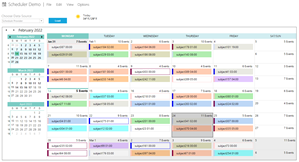Trusted by the world’s leading companies

Overview
The WinForms Scheduler control (Event Calendar) allows users to schedule and manage appointments through an intuitive user interface. It has different view modes such as day, week, work week, and month view to display appointments. Its rich feature set includes recurring appointments, appointment drag and drop, appearance customization, globalization, localization, and more.
Microsoft Outlook Calendar-like User Interface
The Scheduler for Windows Forms has day, week, work week, month, and custom views, similar to Outlook. It is used to create appointments and events, organize meetings, view group schedules, and much more.
High-Performance
The feature-rich WinForms Scheduler can easily handle a large number of appointments.

Rich User Experience
The user interface is very interactive and lets users perform operations like creating, editing, and rescheduling appointments. Set appointment reminders to notify upcoming appointments.
Highly Customizable
The WinForms Scheduler can easily be customized based on the requirement. Time intervals for appointments can also be customized. Provide a unique and consistent look to your scheduler with appearance customization using styles, data templates, and themes.


Recurrence Patterns
Specify daily, weekly, monthly, and yearly recurrence patterns for appointments.
Localization
All visible strings in the WinForms Schedular user interface can be localized to any desired language.


Themes
The WinForms Scheduler control comes with a large number of themes to quickly create elegant interfaces that look and feel like Windows, Office, Outlook, and other popular platforms.
Localization
All visible strings in the user interface can be localized to any desired language.


Themes
The WinForms Scheduler control comes with a large number of themes to quickly create elegant interfaces that look and feel like Windows, Office, Outlook, and other popular platforms.
WinForms Scheduler Code Example
Easily get started with the WinForms Scheduler control (Event Calendar) using a few simple lines of C# code example as demonstrated below. Also explore our WinForms Scheduler Example that shows you how to render and configure the WinForms Scheduler.
using Syncfusion.Schedule;
using Syncfusion.Windows.Forms.Schedule;
namespace WindowsFormsApplication1
{
public partial class Form1 : Form
{
ScheduleControl scheduleControl1;
public Form1()
{
InitializeComponent();
scheduleControl1 = new ScheduleControl();
scheduleControl1.Location = new Point(82, 12);
scheduleControl1.Size = new Size(350, 360);
this.Controls.Add(scheduleControl1);
this.Load += Form1_Load;
}
private void Form1_Load(object sender, EventArgs e)
{
ArrayListDataProvider data = new ArrayListDataProvider(); //Updating datasource items
data.MasterList = new ArrayListAppointmentList();
data.FileName = "default.schedule";
this.scheduleControl1.ScheduleType = ScheduleViewType.Month;
this.scheduleControl1.DataSource = data;
}
}
}Not sure how to create your first WinForms Scheduler? Our documentation can help.
I’d love to read it now125+ WINDOWS FORMS CONTROLS
Frequently Asked Questions
Why should you choose Syncfusion WinForms Scheduler?
The Syncfusion WinForms Scheduler control provides the following features:
Plan and manage recurring appointments easily.
Choose from different view modes such as day, week, work week, and month view to display appointments.
- Easily drag and drop an appointment from one time slot to another.
- One of the best WinForms Scheduler in the market that offers feature-rich UI to interact with the software
- Simple configuration and API.
- Built-in support for exporting the Scheduler control into various formats.
- Save or load a Scheduler control to an XML file.
Extensive demos and documentation to learn quickly and get started with WinForms Scheduler.
Where can I find the Syncfusion WinForms Scheduler demo?
You can find our WinForms Scheduler demo on GitHub location.
Can I download and utilize the Syncfusion WinForms Scheduler for free?
No, this is a commercial product and requires a paid license. However, a free community license is also available for companies and individuals whose organizations have less than $1 million USD in annual gross revenue, 5 or fewer developers, and 10 or fewer total employees.
How do I get started with Syncfusion WinForms Scheduler?
A good place to start would be our comprehensive getting started documentation.
Our Customers Love Us


 Documentation
Documentation
Awards
Greatness—it’s one thing to say you have it, but it means more when others recognize it. Syncfusion® is proud to hold the following industry awards.
















